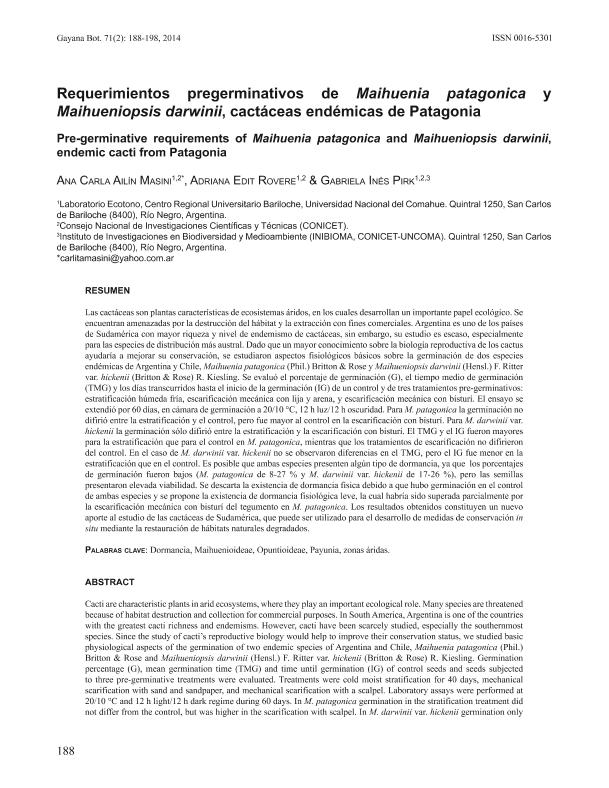Mostrar el registro sencillo del ítem
dc.contributor.author
Masini, Ana Carla Ailín

dc.contributor.author
Rovere, Adriana

dc.contributor.author
Pirk, Gabriela Inés

dc.date.available
2021-03-01T20:02:47Z
dc.date.issued
2014-12
dc.identifier.citation
Masini, Ana Carla Ailín; Rovere, Adriana; Pirk, Gabriela Inés; Requerimientos pregerminativos de maihuenia patagonica y maihueniopsis darwinii, cactáceas endémicas de patagonia; Ediciones Univ; Gayana. Botánica; 71; 2; 12-2014; 188-198
dc.identifier.issn
0016-5301
dc.identifier.uri
http://hdl.handle.net/11336/127077
dc.description.abstract
Cacti are characteristic plants in arid ecosystems, where they play an important ecological role. Many species are threatened because of habitat destruction and collection for commercial purposes. In South America, Argentina is one of the countries with the greatest cacti richness and endemisms. However, cacti have been scarcely studied, especially the southernmost species. Since the study of cacti’s reproductive biology would help to improve their conservation status, we studied basic physiological aspects of the germination of two endemic species of Argentina and Chile, Maihuenia patagonica (Phil.) Britton & Rose and Maihueniopsis darwinii (Hensl.) F. Ritter var. hickenii (Britton & Rose) R. Kiesling. Germination percentage (G), mean germination time (TMG) and time until germination (IG) of control seeds and seeds subjected to three pre-germinative treatments were evaluated. Treatments were cold moist stratification for 40 days, mechanical scarification with sand and sandpaper, and mechanical scarification with a scalpel. Laboratory assays were performed at 20/10 °C and 12 h light/12 h dark regime during 60 days. In M. patagonica germination in the stratification treatment did not differ from the control, but was higher in the scarification with scalpel. In M. darwinii var. hickenii germination only differed between the stratification and the scarification with scalpel. TMG and IG were higher in the stratification treatment than in the control for M. patagonica, whereas scarification treatments did not differ from the control. As for M. darwinii var. hickenii no differences were detected for TMG, but the IG was lower in the stratification than in the control. Probably both species presents some kind of dormancy, since germination percentages were low (M. patagonica between 8-27 % and M. darwinii var. hickenii between 17-26 %) but seeds presented high viability. Presence of physical dormancy is discarded because control seeds of both species germinated and the presence of non deep physiological dormancy is proposed. The latter was partially overcome by mechanical scarification in M. patagonica. These results are a new contribution to the study of cacti in South America and could help to develop in situ conservation strategies through the restoration of degraded areas.
dc.format
application/pdf
dc.language.iso
spa
dc.publisher
Ediciones Univ

dc.rights
info:eu-repo/semantics/openAccess
dc.rights.uri
https://creativecommons.org/licenses/by-nc/2.5/ar/
dc.subject
ARID ZONES
dc.subject
DORMANCY
dc.subject
MAIHUENIOIDEAE
dc.subject
OPUNTIOIDEAE
dc.subject
PAYUNIA
dc.subject.classification
Otras Ciencias Agrícolas

dc.subject.classification
Otras Ciencias Agrícolas

dc.subject.classification
CIENCIAS AGRÍCOLAS

dc.title
Requerimientos pregerminativos de maihuenia patagonica y maihueniopsis darwinii, cactáceas endémicas de patagonia
dc.title
Pre-germinative requirements of maihuenia patagonica and maihueniopsis darwinii, endemic cacti from Patagonia
dc.type
info:eu-repo/semantics/article
dc.type
info:ar-repo/semantics/artículo
dc.type
info:eu-repo/semantics/publishedVersion
dc.date.updated
2021-02-26T19:18:34Z
dc.identifier.eissn
0717-6643
dc.journal.volume
71
dc.journal.number
2
dc.journal.pagination
188-198
dc.journal.pais
Chile

dc.journal.ciudad
Concepción
dc.description.fil
Fil: Masini, Ana Carla Ailín. Universidad Nacional del Comahue. Centro Regional Universitario Bariloche. Laboratorio de Ecotono; Argentina. Consejo Nacional de Investigaciones Científicas y Técnicas. Centro Científico Tecnológico Conicet - Patagonia Norte; Argentina
dc.description.fil
Fil: Rovere, Adriana. Universidad Nacional del Comahue. Centro Regional Universitario Bariloche. Laboratorio de Ecotono; Argentina. Consejo Nacional de Investigaciones Científicas y Técnicas. Centro Científico Tecnológico Conicet - Patagonia Norte; Argentina
dc.description.fil
Fil: Pirk, Gabriela Inés. Universidad Nacional del Comahue. Centro Regional Universitario Bariloche. Laboratorio de Ecotono; Argentina. Consejo Nacional de Investigaciones Científicas y Técnicas. Centro Científico Tecnológico Conicet - Patagonia Norte. Instituto de Investigaciones en Biodiversidad y Medioambiente. Universidad Nacional del Comahue. Centro Regional Universidad Bariloche. Instituto de Investigaciones en Biodiversidad y Medioambiente; Argentina
dc.journal.title
Gayana. Botánica

dc.relation.alternativeid
info:eu-repo/semantics/altIdentifier/url/https://scielo.conicyt.cl/scielo.php?script=sci_arttext&pid=S0717-66432014000200002
dc.relation.alternativeid
info:eu-repo/semantics/altIdentifier/doi/http://dx.doi.org/10.4067/S0717-66432014000200002
Archivos asociados
